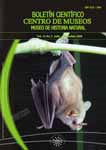Authors
Abstract
Lepidoptera is a group of insects which show high diversity and are common in the dry tropical forests. In this area, butterflies feed, reproduce, migrate and some species lay their eggs on leafs there, which enables the use of this group as bioindicator, related to the degree of conservation of the ecosystem. Therefore, it is necessary to find possibilities to characterize rescue and conserve these organisms. This research will increase the butterfly inventory of the dry tropical forest fragments of the department of Atlantico. It will also contribute more information on the distribution of butterfly species in Colombia and on the butterflyrich areas. This paper reports 123 species ofrom the six families of the Neotropical Region; the majority of species belong to the Pyrginae (Hesperiidae), Biblidinae (Nymphalidae) and Theclinae (Lycaenidae) subfamilies. Some species show outstanding ecological specifications, some associated to biotypes within the forests, for example Myscelia leucocyana (Biblidinae), or in places with a high degree of anthropic intervention, for example Leptotes cassius. The most common species are (27.27% of the populations): Parides anchises, Mechanitis lysimnia, Callicore pitheas, Typhedanus undulatus, Chlosyne lacinia and Heliconius erato. The ecological importance of areas such as San Juan de Tocagua (Luruaco) and Guaibana (Repelón), where exclusive species are found, and which are difficult to sight, are cited in the text. Some of the best conserved and most extensive forest remains within the department are presented.
References
BROWN JR., K. S., 1991. Conservation of Neotropical environments: insects as indicators: 349-404 (in) N. M. COLLINS & J. A. THOMAS (eds.) The conservation of insects and their habitats. Royal Entomological Society Symposium XV, Academic Press, London, England.
CONSTANTINO, L. M., 1996. Ciclos de vida y plantas hospederas de lepidópteros con potencial económico en condiciones de colinas bajas del Chocó biogeográfico. Investigación y manejo de fauna para la construción de sistemas sostenibles. CIPAV, Cali, Valle. p. 75-86.
________., 1997. Lepidópteros diurnos del Chocó biogeogeográfico: Biodiversidad, alternativas productivas sostenibles y estrategias de conservación. Memorias XXIV congreso de SOCOLEN. p. 47-72.
________., 1998. Butterfly life history studies. Diversity, Ranching and conservation in Chocó rain forest of Western Colombia (Inseta: Lepidoptera). SHILAP Revta. Lepid., 26 (101): 19-39.
D`ABRERA, B., 1981. Butterflies of the Neotropical Region. Part 1. Papilionidae and Pieridae. Melbourne, Australia: Landsdowne.
___________., 1986. Butterflies of the Neotropical Region. Part 2. Danaidae, Ithomiidae, Heliconiidae & Morphidae. Melbourne, Australia: Hill House Publishers.
___________., 1994. Butterflies of the Neotropical Region. Part VI. Riodinidae. Melbourne, Australia: Hill House Publishers.
___________., 1995. Butterflies of the Neotropical Region. Part VII. Lycaenidae. Hill House Publishers. Melbourne, Australia.
DE VRIES, P.J., 1987. Butterflies of Costa Rica and their natural history. Volumen I. Papilionidae, Pieridae, Nymphalinae. Oxford: Princeton Univ. Press.
___________., 1997. Butterflies of Costa Rica and their natural history. Volumen II. Riodinidae. Oxford: Princeton Univ. Press.
FREITAS, A. V. L., R. B; FRANCINI & BROWN, K.S., JR., 2003. Insetos como indicadores ambientais (in) L. CULLEN, R. RUDRAN & C. VALLADARES-PÁDUA (eds.) Manual Brasileiro em Biologia da Conservação, in press. Washington, D.C.: Smithsonian Institution Press.
HINCAPIÉ, N., 2001. Contribución al conocimiento del Orden Lepidóptera (Rhopalocera), en la región de Santa Marta, Colombia. Informe 9. 65 p.
HUERTAS, B., 2004. Butterfly Diversity in the Serranía de los Yariguíes: Elevational Distribution, Rapid Assessment Inventories and Conservation in the Colombian Andes (Lepidoptera: Papilionoidea and Hesperoidea): M.Sc Thesis, Imperial College, University of London and Natural History Museum.
INSTITUTO DE INVESTIGACIÓN EN RECURSOS BIOLÓGICOS ALEXANDER VON HUMBOLDT, (IAvH)., n) L. Exploración ecológica a los fragmentos de Bosque seco en el valle del Río Magdalena (Norte del departamento del Tolima). Informe GEMA_01.
INSTITUTO GEOGRÁFICO AGUSTÍN CODAZZI, (IGAC)., 1994. Características Geográficas del Departamento del Atlántico. Bogotá. 93 p.
KREMEN, C., 1992. Assessing the indicator properties of species assemblages for natural areas monitoring. Butterflies as indicators. Ecologial Applications, 2: 203-217.
________., 1994. Biological Inventory using target taxa. A case study of butterflies of Madagascar. Ecological applications, 4 (3): 407-422.
KREMEN, C., R. COLWELL, T. ERWIN, D. MURPHY, R. NOSS & SANJAYAN, M., 1993. Terrestrial arthropod assemblages: their use in conservation planning. Conservation Biology, 7 (4): 796-808.
LAMAS G., 2003. Estado Actual del Conocimiento de la Sistemática de los Lepidópteros con Especial Referencia a la Región Neotropical. Bol. Soc. Ent. Ar., 32 p.
LE CROM. J, CONSTANTINO. L. M. & SALAZAR J. A., 2003. Mariposas de Colombia. Tomo 1. Familia Papilionidae. Carlec Ltda. Edición Española, Bogotá.
MONTERO, F., 2005. Las Mariposas (Lepidóptera: Rhopalocera) de el Lago el Cisne. Barranquilla Atlántico. Memorias de II Conversatorio Regional de Investigaciones Biológicas. Barranquilla.
MONTERO, F. & DE LAS SALAS, J. L., 2005. Mariposas diurnas (Lepidóptera: Rhopalocera) de Bahía Concha, Parque Nacional Natural Tayrona (Magdalena-Colombia). Resúmenes del XXXII Congreso de SOCOLEN, Ibagué (Colombia), (104). 167 p.
MONTERO, F. & MORENO, M., 2006. Áreas con potencial de uso como zonas de conservación de fauna y flora en el departamento del Atlántico. Tomo Mariposas. Universidad del Atlántico - Corporación Autónoma Regional del Atlántico (CRA) (Fabricius, 1775):
OROZCO, S. MURIEL, S. & PALACIO, J., 2009. Diversidad de Lepidópteros diurnos en un área de bosque seco tropical del occidente antioqueño. Actual. Biol., 31 (90): 31-41.
URIBE, C. & SALAZAR, J. A. Mariposas del Llano. Naturaleza de la Orinoquia, Bogotá: Cristina Uribe Editores. 104 p.
VÉLEZ, J. & SALAZAR. J. A., 1991. Mariposas de Colombia. Bogotá: Villegas Editores. 167 p.

 PDF (Español)
PDF (Español)
 FLIP
FLIP


















